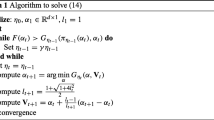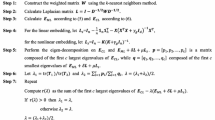Abstract
Many clustering methods may have poor performance when the data structure is complex (i.e., the data has an aspheric shape or non-linear relationship). Inspired by this view, we proposed a clustering model which combines kernel function and Locality Preserving Projections (LPP) together. Specifically, we map original data into the high-dimensional feature space according to the idea of kernel function. Secondly, it is feasible to explore the local structure of data in clustering tasks. LPP is used to preserve the original local structure information of data to improve the validity of the clustering model. Finally, some outliers are often included in real data, so we embedded sparse regularization items in the model to adjust feature weights and remove outliers. In addition, we design a simple iterative optimization method to solve the final objective function and show the convergence of the optimization method in the experimental part. The experimental analysis of ten public data sets showed that our proposed method has better efficiency and performance in clustering tasks than existing clustering methods.



Similar content being viewed by others
References
Aït-Sahalia Y, Xiu D (2019) Principal component analysis of high-frequency data. J Am Stat Assoc 114(525):287–303
Baudat G, Anouar F (2000) Generalized discriminant analysis using a kernel approach. Neural Comput 12(10):2385–2404
Ben-Hur A, Horn D, Siegelmann HT, Vapnik V (2001) Support vector clustering. J Mach Learn Res 2(2):125–137
Bourgain J, Dirksen S, Nelson J (2015) Toward a unified theory of sparse dimensionality reduction in euclidean space. Geom Funct Anal 25(4):1009–1088
Camastra F, Verri A (2005) A novel kernel method for clustering. IEEE Trans Pattern Anal Mach Intell 27(5):801–805
Chen S, Zhao H, Kong M, Luo B (2007) 2d-lpp: a two-dimensional extension of locality preserving projections. Neurocomputing 70(4):912–921
Chiang JH, Hao PY (2003) A new kernel-based fuzzy clustering approach: support vector clustering with cell growing. IEEE Trans Fuzzy Syst 11(4):518–527
Dhanachandra N, Manglem K, Chanu YJ (2015) Image segmentation using k -means clustering algorithm and subtractive clustering algorithm. Proc Comput Sci 54:764–771
Gao L, Li X, Song J, Shen HT (2019) Hierarchical LSTMS with adaptive attention for visual captioning. IEEE Trans Pattern Anal Mach Intell. https://doi.org/10.1109/TPAMI.2019.2894139
Graves D, Pedrycz W (2010) Kernel-based fuzzy clustering and fuzzy clustering: a comparative experimental study. Fuzzy Sets Syst 161(4):522–543
Gui J, Sun Z, Ji S, Tao D, Tan T (2017) Feature selection based on structured sparsity: a comprehensive study. IEEE Trans Neural Netw Learn Syst 28(7):1490–1507
Halkidi M, Batistakis Y, Vazirgiannis M (2001) On clustering validation techniques. J Intell Inf Syst 17(2–3):107–145
Hartigan JA, Wong MA (1979) Algorithm as 136: a k-means clustering algorithm. J Roy Stat Soc 28(1):100–108
He X, Niyogi P (2004) Locality preserving projections. In: Thrun S, Saul LK, Schölkopf B (eds) Advances in neural information processing systems. MIT Press, pp. 153–160. http://papers.nips.cc/paper/2359-locality-preserving-projections.pdf
Hu R, Zhu X, Zhu Y, Gan J (2019) Robust SVM with adaptive graph learning. World Wide Web. https://doi.org/10.1007/s11280-019-00766-x
Inokuchi R, Miyamoto S (2004) LVQ clustering and SOM using a kernel function. In: 2004 IEEE international conference on fuzzy systems (IEEE cat. no. 04CH37542), vol 3. IEEE, pp 1497–1500
Jain AK, Dubes RC et al (1988) Algorithms for clustering data, vol 6. Prentice Hall, Englewood Cliffs
Ji Y, Zhan Y, Yang Y, Xu X, Shen F, Shen HT (2019) A knowledge map guided coarse-to-fine action recognition. IEEE Trans Image Process. https://doi.org/10.1109/TIP.2019.2952088
Kalousis A, Prados J, Hilario M (2007) Stability of feature selection algorithms: a study on high-dimensional spaces. Knowl Inf Syst 12(1):95–116
Kannan SR, Sathya A, Sathya A, Sathya A (2011) Robust kernel FCM in segmentation of breast medical images. Expert Syst Appl Int J 38(4):4382–4389
Lei Z, Zhu S (2007) Face recognition based on orthogonal discriminant locality preserving projections. Neurocomputing 70(7):1543–1546
Li Z, Zhang Z, Qin J, Zhang Z, Shao L (2019) Discriminative fisher embedding dictionary learning algorithm for object recognition. IEEE Trans Neural Netw Learn Syst 99(1):1–14
Liu Y, Jiao L, Shang F (2013) An efficient matrix factorization based low-rank representation for subspace clustering. Pattern Recogn 46(1):284–292
Luxburg UV (2007) A tutorial on spectral clustering. Stat Comput 17(4):395–416
Müller KR, Mika S, Rätsch G, Tsuda K, Schölkopf B (2001) An introduction to kernel-based learning algorithms. IEEE Trans Neural Netw 12(2):181
Nesterov Y (2018) Lectures on convex optimization, vol 137. Springer, Berlin
Ng AY, Jordan MI, Weiss Y (2001) On spectral clustering: analysis and an algorithm. Proc Nips 14:849–856
Nie F, Rui Z, Xuelong LI (2017) A generalized power iteration method for solving quadratic problem on the stiefel manifold. Sci China (Information Sciences) 60(11):112101
Nie F, Xu D, Tsang IW, Zhang C (2009) Spectral embedded clustering. In: International joint conference on artificial intelligence
Noble WS (2006) What is a support vector machine? Nat Biotechnol 24(12):1565
Patel VM, Van Nguyen H, Vidal R (2013) Latent space sparse subspace clustering. In: Proceedings of the IEEE international conference on computer vision, pp 225–232
Ren X, Elkishky A, Wang C, Tao F, Voss CR, Ji H, Han J (2015) Clustype: effective entity recognition and typing by relation phrase-based clustering. In: Kdd 2015, pp 995–1004
Roweis ST, Saul LK (2000) Nonlinear dimensionality reduction by locally linear embedding. Science 290(5500):2323–2326
Sánchez A VD (2003) Advanced support vector machines and kernel methods. Neurocomputing 55(1–2):5–20
Santos JM, Embrechts M (2009) On the use of the adjusted rand index as a metric for evaluating supervised classification. In: International conference on artificial neural networks. Springer, pp 175–184
Schlittgen R (2011) A weighted least-squares approach to clusterwise regression. Asta Adv Stat Anal 95(2):205–217
Schölkopf B, Smola A, Müller KR (1998) Nonlinear component analysis as a kernel eigenvalue problem. Neural Comput 10(5):1299–1319
Wang B, Yang Y, Xu X, Hanjalic A, Shen HT (2017) Adversarial cross-modal retrieval. In: Proceedings of the 2017 ACM on multimedia conference, pp 154–162
Wang S, Nie F, Chang X, Li X, Sheng QZ, Yao L (2016) Uncovering locally discriminative structure for feature analysis. In: Joint European conference on machine learning and knowledge discovery in databases. Springer, pp 281–295
Wang W, Liu B, Guan H, Zhou Y, Xia S (2015) Spectral embedded clustering algorithm based on kernel function. J Comput Appl 35(3):761–765,810
Wen G (2019) Robust self-tuning spectral clustering. Neurocomputing. https://doi.org/10.1016/j.neucom.2018.11.105
Xie GS, Zhang Z, Liu L, Zhu F, Zhang XY, Shao L, Li X (2019) SRSC: selective, robust, and supervised constrained feature representation for image classification. IEEE Trans Neural Netw Learn Syst 99(1):1–14
Zhan M, Lu G, Wen G, Zhang L, Wu L (2019) A clustering algorithm via kernel function and locality preserving projections. In: IEEE symposium series on computational intelligence
Zhang DQ, Chen SC (2003) Clustering incomplete data using kernel-based fuzzy c-means algorithm. Neural Process Lett 18(3):155–162
Zhang S, Wong HS (2010) ARIMP: a generalized adjusted rand index for cluster ensembles. In: 2010 20th international conference on pattern recognition. IEEE, pp 778–781
Zhang Z, Lai Z, Huang Z, Wong W, Xie G, Liu L, Shao L (2019) Scalable supervised asymmetric hashing with semantic and latent factor embedding. IEEE Trans Image Process 28(10):4803–4818
Zhang Z, Liu L, Shen F, Shen HT, Shao L (2019) Binary multi-view clustering. IEEE Trans Pattern Anal Mach Intell 41(7):1774–1782
Zheng Q, Liu Z (2016) Research on improved normalized cut spectral clustering algorithm. In: 2016 Chinese control and decision conference (CCDC). IEEE, pp 1981–1984
Zheng W, Zhu X, Zhu Y, Hu R, Lei C (2018) Dynamic graph learning for spectral feature selection. Multimed. Tools Appl. 77(22):29739–29755
Zhu X, Gan J, Lu G, Li J, Zhang S (2019) Spectral clustering via half-quadratic optimization. World Wide Web. https://doi.org/10.1007/s11280-019-00731-8
Zhu X, Li X, Zhang S, Xu Z, Yu L, Wang C (2017) Graph PCA hashing for similarity search. IEEE Trans Multimed 19(9):2033–2044
Zhu X, Yang J, Zhang C, Zhang S (2019) Efficient utilization of missing data in cost-sensitive learning. IEEE Trans Knowl Data Eng. https://doi.org/10.1109/TKDE.2019.2956530
Zhu X, Zhang S, Hu R, He W, Lei C, Zhu P (2019) One-step multi-view spectral clustering. IEEE Trans Knowl Data Eng 31(10):2022–2034
Zhu X, Zhang S, Li Y, Zhang J, Yang L, Fang Y (2019) Low-rank sparse subspace for spectral clustering. IEEE Trans Knowl Data Eng 31(8):1532–1543
Zhu X, Zhu Y, Zheng W (2019) Spectral rotation for deep one-step clustering. Pattern Recognit. https://doi.org/10.1016/j.patcog.2019.107175
Acknowledgements
This work is partially supported by the China Key Research Program (Grant No: 2016YF-B1000905); the Key Program of the National Natural Science Foundation of China (Grant No: 61836016); the Natural Science Foundation of China (Grants No: 61876046, 61573270, 81701780 and 61672177); the Project of Guangxi Science and Technology (GuiKeAD17195062); the Guangxi Natural Science Foundation (Grant No: 2017GXNSFBA198221); the Guangxi Collaborative Innovation Center of Multi-Source Information Integration and Intelligent Processing; the Guangxi High Institutions Program of Introducing 100 High-Level Overseas Talents; and the Research Fund of Guangxi Key Lab of Multisource Information Mining & Security (18-A-01-01); Innovation Project of Guangxi Graduate Education (Grants No: YCSW2020108, JXXYYJSCXXM-008).
Author information
Authors and Affiliations
Corresponding author
Additional information
Publisher's Note
Springer Nature remains neutral with regard to jurisdictional claims in published maps and institutional affiliations.
Rights and permissions
About this article
Cite this article
Zhan, M., Lu, G., Wen, G. et al. Using Locality Preserving Projections to Improve the Performance of Kernel Clustering. Neural Process Lett 52, 1827–1842 (2020). https://doi.org/10.1007/s11063-020-10252-5
Published:
Issue Date:
DOI: https://doi.org/10.1007/s11063-020-10252-5




